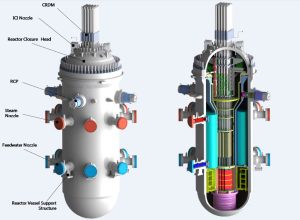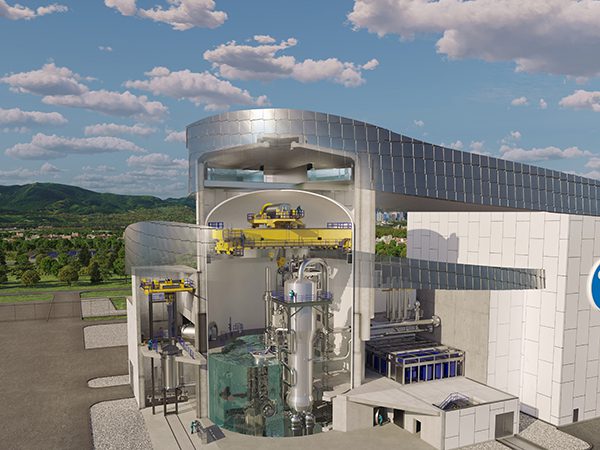Machinery
Small Modular Reactors; Future of Modern Nuclear power generators

Economic factors of scale showed that nuclear reactors tended to be larger to such an extent that size alone became a limiting factor to favour small modular reactors (SMRs) today. Safety issues like with the 1986 Chernobyl disaster and the 2011 Fukushima nuclear disaster caused a major set-back for the nuclear industry, with worldwide suspension of development, cutting down of funding and closure of reactor plants. A new strategy was introduced aiming at building smaller reactors, faster to realize, more safely and at lower costs for a single reactor.
Small modular reactors (SMRs) are nuclear fission reactors that are smaller than conventional nuclear reactors. They can be constructed in one location (typically a factory) and shipped to the site where they will operate. They typically have an electrical power output of less than 300 MWe (electric) or a less than 1000 MWth (thermal).

Illustration of a small modular nuclear reactor SMR
The term SMR refers to the size, capacity and modular construction only, not to the reactor type and the nuclear process which is applied. Designs range from scaled down versions of existing designs to generation IV designs. Both thermal-neutron reactors and fast-neutron reactors have been proposed, along with molten salt and gas cooled reactor models.
Many SMRs rely on a manufacturing-centric model, the requirement for many deployments to secure to large economies of unit production necessary to achieve economic viability. Some SMRs, typically those using Generation IV technologies, secure additional economic advantage and in some case large, through improvements in electrical generating efficiency from much higher temperature steam generation.
While there are dozens of modular reactor designs and yet unfinished demonstration projects, the floating nuclear power plant Akademik Lomonosov, operating in Pevek in Russia’s Far East, was as of May 2020 the first and only operating prototype in the world. The concept is based on the design of nuclear icebreakers. The construction of the world’s first commercial land-based SMR started in July 2021 with the Chinese power plant Linglong One (Chinese: 玲珑一号). The operation of this prototype is due to start by the end of 2026.
SMRs differ in terms of staffing, security and deployment time. US government studies to evaluate SMR-associated risks have slowed licensing. One concern with SMRs is preventing nuclear proliferation.
Types of Small Modular Reactors, SMRs
Small Modular Reactors are envisioned in multiple designs types. Some are simplified versions of current reactors, others involve entirely new technologies. All proposed SMRs use nuclear fission with designs including thermal-neutron reactors and fast-neutron reactors.
Thermal-neutron reactors
Thermal-neutron reactors rely on a moderator to slow neutrons and generally use 235U as fissile material. Most conventional operating reactors are of this type.
Fast reactors
Fast reactors don’t use moderators. Instead they rely on the fuel to absorb higher speed neutrons. This usually means changing the fuel arrangement within the core, or using different fuels. E.g., 239Pu is more likely to absorb a high-speed neutron than 235U.
Fast reactors can be breeder reactors. These reactors release enough neutrons to transmute non-fissionable elements into fissionable ones. A common use for a breeder reactor is to surround the core in a “blanket” of 238U, the most easily found isotope. Once the 238U undergoes a neutron absorption reaction, it becomes 239Pu, which can be removed from the reactor during refueling, and subsequently used as fuel.
Scalability
Licensing
Design

Small Modular Reactor Design illustration
Cooling
Conventional reactors use water as a coolant. SMRs may use water, liquid metal, gas and molten salt as coolants. Coolant type is determined based on the reactor type, reactor design, and the chosen application. Large-rated reactors primarily use light water as coolant, allowing for this cooling method to be easily applied to Small Modular Reactors. Helium is often elected as a gas coolant for SMRs because it yields a high plant thermal efficiency and supplies a sufficient amount of reactor heat. Sodium, lead, and lead-bismuth are common liquid metal coolants of choice for SMRs. There was a large focus on sodium during early work on large-rated reactors which has since carried over to SMRs to be a prominent choice as a liquid metal coolant.
SMRs have lower cooling water requirements, which expands the number of places a SMR could be built to include remote areas such as mining and desalination.
Thermal/electrical generation
Some gas-cooled reactor designs drive a gas-powered turbine, rather than boil water. Thermal energy can be used directly, without conversion. Heat can be used in hydrogen production and other commercial operations, such as desalination and the production of petroleum products (extracting oil from oil sands, creating synthetic oil from coal, etc.).
Load following
SMR designs can provide base load power or can adjust their output based on demand. Another approach, especially for Small Modular Reactors that can provide high temperature heat, is to adopt cogeneration, maintaining consistent output, while diverting otherwise unneeded heat to an auxiliary use.
District heating, desalination and hydrogen production have been proposed as cogeneration options. Overnight desalination requires sufficient freshwater storage to enable water to be delivered at times other than when it is produced. Membrane and thermal are the two principal categories of desalination technology. The membrane desalination process uses only electricity and is employed the most out of the two technologies. In the thermal process, the feed water stream is evaporated in different stages with continuous decreases in pressure between the stages. The thermal process primarily uses thermal energy and does not include the intermediate conversion of thermal power to electricity. Thermal desalination technology is further divided into two principal technologies: the Multi Stage Flash distillation (MSF) and the Multi Effect Desalination (MED).
Waste
Many SMR designs are fast reactors that have higher fuel burnup, reducing the amount of waste. At higher neutron energy more fission products can usually be tolerated. Breeder reactors “burn”235U, but convert fertile materials such as 238U into usable fuels.
Some reactors are designed to run on the thorium fuel cycle, which offers significantly reduced long-term waste radiotoxicity compared to the uranium cycle. The traveling wave reactor immediately uses fuel that it breeds without requiring the fuel’s removal and cleaning.
A report by the German Federal Office for the Safety of Nuclear Waste Management found that extensive interim storage and fuel transports would still be required for SMRs. A repository would still be required in any case.
One study reported that some types of SMR could produce more waste per unit of output than conventional reactors, in some cases more than 5x the spent fuel per kilowatt, and as much as 35x other waste products, such as active steel. Neutron leakage rates were estimated to be higher for SMRs, because in smaller reactor cores, emitted neutrons have fewer chances to interact with the fuel. Instead, they exit the core, where they are absorbed by the shielding, turning it radioactive. Reactor designs that use liquid metal coolants also become radioactive.
Another potential issue is that a lower fraction of the fuel is consumed, increasing waste volumes. The potentially increased diversity of reactors may require accordingly diverse wase management systems.
Flexibility of SMR
Small nuclear reactors in comparison to conventional nuclear power generation plants offer many notable technological advancements due to the flexibility of their modular construction.
SMRs offer significant advantages over conventional style nuclear reactors due to the flexibility of their modular design. Flexibility in the capabilities of SMRs offers advantages, incremental load capacity, and ability for adaptation to current nuclear power plant sites, utilization for industrial applications, improved operating time, and finally the ability to be “grid independent”.
This flexibility in the modularity of a SMR system allows for additional units to be incrementally added in the event where load on the grid increases. Additionally, this flexibility in a standardized SMRs design revolving around modularity allows for rapid production at a decreasing cost following the completion of the first reactor on site.
The flexibility and modularity of SMR allows this form of power generation to be installed at existing power plants; therefore, allowing for SMRs to supply additional energy to the aging grid of fossil fuel power plants with an easy adaptation to the existing grid structure. Modularity of a SMR plant allows for “a single site can have multiple SMRs, allowing one to go off-line for refueling while the other reactors stay online”.
The flexibility of SMRs provides additional opportunities for industrial usage through saving energy lost through the transfer of energy from thermal to electrical. Applications for a SMR under these conditions of direct energy transfer include “desalination, industrial processes, hydrogen production, oil shale recovery, and district heating” of which a conventional large reactor is not capable.
Safety Design for SMRs
Coolant systems can use natural circulation convection to eliminate pumps that could break down. Convection can keep removing decay heat after reactor shutdown.
Negative temperature coefficients in the moderators and the fuels keep the fission reactions under control, causing the reaction to slow as temperature increases.
Some Small Modular Reactors may need an active cooling system to back up the passive system, increasing cost. Additionally, SMR designs have less need for containment structures.
Containment is more efficient, and proliferation concerns are much less. For example, a pressure release valve may have a spring that can respond to increasing pressure to increase coolant flow. Inherent safety features require no moving parts to work, depending only on physical laws. Another example is a plug at the bottom of a reactor that melts away when temperatures are too high, allowing the reactor fuel to drain out of the reactor and lose critical mass.
Some Small Modular Reactors designs bury the reactor and spent-fuel storage pools underground. Smaller reactors would be easier to upgrade.
SMRs maintain core cooling with a passive safety system which eliminates the need for pressure injection systems. With a passive safety system, emergency AC power sourced from a diesel generator is not required for core cooling. A passive safety system is simpler, requires less testing, and does not lead to inadvertent initiation. SMRs do not require an active containment heat system due to passive heat rejection out of containment and a containment spray system is not required. An emergency feed water system in not necessary for SMRs, allowing for core heat removal and enhancing safety.
Small Modular Reactors featuring water and sodium coolants increase reactor safety through their ability to withhold byproducts of the fissile fuel introduced into the coolants during a severe accident. This characteristic of a SMR allows for the ability of a SMR to mitigate the release of fissile material, contaminating the environment, in the event of a failure to maintain containment of nuclear material occurred.
Some Small Modular Reactors designs feature an integral design of which the primary reactor core, steam generator and the pressurizer are integrated within the sealed reactor vessel. This integrated design allows for the reduction of a possible accident as radiation leaks can easily be contained.
In comparison to larger reactors having numerous components outside the reactor vessel, this feature drastically increases the safety by decreasing the chance of an uncontained accident. Furthermore, this feature allows many SMR designs bury the reactor and spent-fuel storage pools underground at the end of their service life therefore increasing the safety of waste disposal
List of Some Small Modular Reactors designs
Infrastructure Layout/Siting

SMRs site layout
Proposed sites




2 Comments